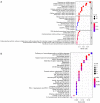Identification and validation of a ferroptosis-related prognostic risk-scoring model and key genes in small cell lung cancer
- PMID: 35958330
- PMCID: PMC9359951
- DOI: 10.21037/tlcr-22-408
Identification and validation of a ferroptosis-related prognostic risk-scoring model and key genes in small cell lung cancer
Abstract
Background: Small cell lung cancer (SCLC) is an aggressive lung malignancy with high relapse rates and poor survival outcomes. Ferroptosis is a recently identified type of cell death caused by excessive intracellular iron accumulation and lipid peroxidation, which may mediate tumor-infiltrating immune cells to influence anti-cancer immunity. But prognostic value of ferroptosis-related genes and its relationship with the treatment response of immunotherapies in SCLC have not been elucidated.
Methods: The RNA-sequencing and clinical data of SCLC patients were downloaded from the cBioPortal database. A ferroptosis-related prognostic risk-scoring model was constructed based on univariable and multivariable Cox-regression analysis. Kaplan-Meier (K-M) survival curves and receiver operating characteristics (ROC) curves were constructed to assess the sensitivity and specificity of the risk-scoring model. And the correlations between ferroptosis-related prognostic genes and immune microenvironment were explored. The IC50 values of anti-cancer drugs were downloaded from the Genomics of Drug Sensitivity in Cancer (GDSC) database and the correlation analysis with the key gene thioredoxin-interacting protein (TXNIP) was performed. In addition, immunohistochemistry (IHC) staining was employed to detect the expression of TXNIP in 20 SCLC patients who received first-line chemo-immunotherapy. Immunotherapeutic response according to iRECIST (Response Evaluation Criteria in Solid Tumours for immunotherapy trials) were recorded.
Results: We constructed a risk-score successfully dividing patients in the low- and high-risk groups (with better and worse prognosis, respectively). The area under the curve (AUC) of this risk-scoring model was 0.812, showing it had good utility in predicting the prognosis of SCLC. Moreover, ferroptosis-related genes were associated with the degree of immune infiltration of SCLC. Most importantly, we found that the TXNIP expression was highly correlated with the degree of immune invasion and the efficacy of chemotherapy in combination with immunotherapy in SCLC patients.
Conclusions: The ferroptosis-related prognostic risk-scoring model proposed in this study can potentially predict the prognosis of SCLC patients. TXNIP may serve as a potential biomarker to predict the prognosis and efficacy of chemotherapy combined with immunotherapy in SCLC patients.
Keywords: Ferroptosis; immunotherapy; risk-scoring model; small cell lung cancer (SCLC); thioredoxin-interacting protein (TXNIP).
2022 Translational Lung Cancer Research. All rights reserved.
Conflict of interest statement
Conflicts of Interest: All authors have completed the ICMJE uniform disclosure form (available at https://tlcr.amegroups.com/article/view/10.21037/tlcr-22-408/coif). LB received grants from Takeda, AstraZeneca, BMS and Roche; he also received payment for lectures and participated in advisory boards form Invitae, Eli-Lilly, AstraZeneca, Roche, MSD, Merck, BMS, Pfizer, Novartis, Takeda, Janssen; support for attending meeting from Pfizer. He is Int. Secretary-Austrian Society of Pathology; PPS Membership and Awards Committee; Member of the Mesothelioma Committee of IASLC. Mariano Provencio received consulting fees from BMS, MSD, Lilly, Takeda, Janssen; grants from BMS, Lilly, MSD and Takeda; support for attending meetings from MSD and AZ and received payment honoraria for lectures from BMS, MSD, AZ, Takeda. The other authors have no conflicts of interest to declare.
Figures








Similar articles
-
Identification of ferroptosis genes in immune infiltration and prognosis in thyroid papillary carcinoma using network analysis.BMC Genomics. 2021 Jul 27;22(1):576. doi: 10.1186/s12864-021-07895-6. BMC Genomics. 2021. PMID: 34315405 Free PMC article.
-
Construction and validation of a risk scoring model for diffuse large B-cell lymphoma based on ferroptosis-related genes and its association with immune infiltration.Transl Oncol. 2022 Feb;16:101314. doi: 10.1016/j.tranon.2021.101314. Epub 2021 Dec 15. Transl Oncol. 2022. PMID: 34920339 Free PMC article.
-
Diagnostic and predictive significance of the ferroptosis-related gene TXNIP in lung adenocarcinoma stem cells based on multi-omics.Transl Oncol. 2024 Jul;45:101926. doi: 10.1016/j.tranon.2024.101926. Epub 2024 Apr 13. Transl Oncol. 2024. PMID: 38615437 Free PMC article.
-
Ferroptosis, necroptosis, and pyroptosis in the tumor microenvironment: Perspectives for immunotherapy of SCLC.Semin Cancer Biol. 2022 Nov;86(Pt 3):273-285. doi: 10.1016/j.semcancer.2022.03.009. Epub 2022 Mar 12. Semin Cancer Biol. 2022. PMID: 35288298 Review.
-
Deciphering the potential roles of ferroptosis in regulating tumor immunity and tumor immunotherapy.Front Immunol. 2023 Feb 28;14:1137107. doi: 10.3389/fimmu.2023.1137107. eCollection 2023. Front Immunol. 2023. PMID: 36926345 Free PMC article. Review.
Cited by
-
Evaluation of Ferroptosis as a Biomarker to Predict Treatment Outcomes of Cancer Immunotherapy.Cancer Res Commun. 2025 Aug 1;5(8):1288-1297. doi: 10.1158/2767-9764.CRC-25-0268. Cancer Res Commun. 2025. PMID: 40693608 Free PMC article.
-
Emerging mechanisms of ferroptosis and its implications in lung cancer.Chin Med J (Engl). 2024 Apr 5;137(7):818-829. doi: 10.1097/CM9.0000000000003048. Epub 2024 Mar 18. Chin Med J (Engl). 2024. PMID: 38494343 Free PMC article. Review.
-
Muscle-derived factor alleviated cognitive impairment caused by intestinal ischemia-reperfusion.Redox Biol. 2025 Jul;84:103682. doi: 10.1016/j.redox.2025.103682. Epub 2025 May 15. Redox Biol. 2025. PMID: 40388874 Free PMC article.
-
Identification of the potential ferroptosis key genes in lung cancer with bone metastasis.J Thorac Dis. 2023 May 30;15(5):2708-2720. doi: 10.21037/jtd-23-539. Epub 2023 May 29. J Thorac Dis. 2023. PMID: 37324090 Free PMC article.
References
-
- Goldman JW, Dvorkin M, Chen Y, et al. Durvalumab, with or without tremelimumab, plus platinum-etoposide versus platinum-etoposide alone in first-line treatment of extensive-stage small-cell lung cancer (CASPIAN): updated results from a randomised, controlled, open-label, phase 3 trial. Lancet Oncol 2021;22:51-65. 10.1016/S1470-2045(20)30539-8 - DOI - PubMed
LinkOut - more resources
Full Text Sources
